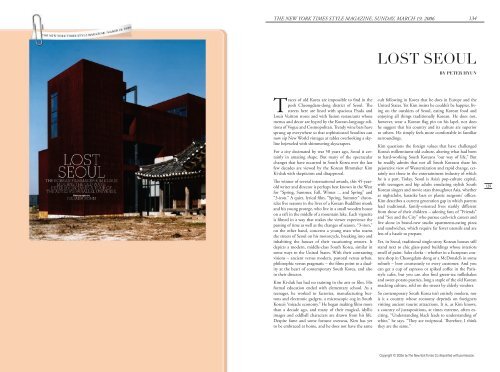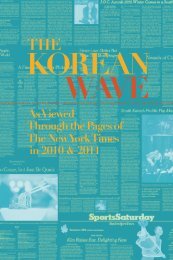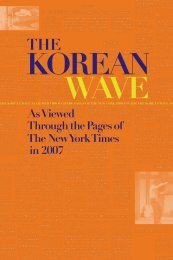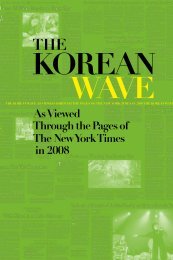The Korean Wave 2006 - Korean Cultural Service
The Korean Wave 2006 - Korean Cultural Service
The Korean Wave 2006 - Korean Cultural Service
Create successful ePaper yourself
Turn your PDF publications into a flip-book with our unique Google optimized e-Paper software.
<strong>The</strong> New York Times style magazine, sunday, march 19, <strong>2006</strong><br />
134<br />
Lost Seoul<br />
By PETER HYUN<br />
Traces of old Korea are impossible to find in the<br />
posh Cheongdam-dong district of Seoul. <strong>The</strong><br />
streets here are lined with spacious Prada and<br />
Louis Vuitton stores and with fusion restaurants whose<br />
menus and decor are hyped by the <strong>Korean</strong>-language editions<br />
of Vogue and Cosmopolitan. Trendy wine bars have<br />
sprung up everywhere so that sophisticated Seoulites can<br />
now sip New World vintages at tables overlooking a skyline<br />
bejeweled with shimmering skyscrapers.<br />
For a city decimated by war 50 years ago, Seoul is certainly<br />
in amazing shape. But many of the spectacular<br />
changes that have occurred in South Korea over the last<br />
few decades are viewed by the <strong>Korean</strong> filmmaker Kim<br />
Ki-duk with skepticism and disapproval.<br />
<strong>The</strong> winner of several international awards, this 45-yearold<br />
writer and director is perhaps best known in the West<br />
for “Spring, Summer, Fall, Winter ... and Spring” and<br />
“3-iron.” A quiet, lyrical film, “Spring, Summer” chronicles<br />
five seasons in the lives of a <strong>Korean</strong> Buddhist monk<br />
and his young protege, who live in a small wooden house<br />
on a raft in the middle of a mountain lake. Each vignette<br />
is filmed in a way that makes the viewer experience the<br />
passing of time as well as the changes of season. “3-iron,”<br />
on the other hand, concerns a young man who roams<br />
the streets of Seoul on his motorcycle, breaking into and<br />
inhabiting the houses of their vacationing owners. It<br />
depicts a modern, middle-class South Korea, similar in<br />
some ways to the United States. With their contrasting<br />
visions – ancient versus modern, pastoral versus urban,<br />
philosophic versus pragmatic – the films point to a duality<br />
at the heart of contemporary South Korea, and also<br />
in their director.<br />
Kim Ki-duk has had no training in the arts or film. His<br />
formal education ended with elementary school. As a<br />
teenager, he worked in factories, manufacturing buttons<br />
and electronic gadgets, a microscopic cog in South<br />
Korea’s “miracle economy.” He began making films more<br />
than a decade ago, and many of their magical, idyllic<br />
images and oddball characters are drawn from his life.<br />
Despite fame and some fortune overseas, Kim has yet<br />
to be embraced at home, and he does not have the same<br />
cult following in Korea that he does in Europe and the<br />
United States. Yet Kim insists he couldn’t be happier, living<br />
on the outskirts of Seoul, eating <strong>Korean</strong> food and<br />
enjoying all things traditionally <strong>Korean</strong>. He does not,<br />
however, wear a <strong>Korean</strong> flag pin on his lapel, nor does<br />
he suggest that his country and its culture are superior<br />
to others. He simply feels more comfortable in familiar<br />
surroundings.<br />
Kim questions the foreign values that have challenged<br />
Korea’s millenniums-old culture, altering what had been<br />
to hard-working South <strong>Korean</strong>s “our way of life.” But<br />
he readily admits that not all South <strong>Korean</strong>s share his<br />
pejorative view of Westernization and rapid change, certainly<br />
not those in the entertainment industry of which<br />
he is a part. Today, Seoul is Asia’s pop-culture capital,<br />
with teenagers and hip adults emulating stylish South<br />
<strong>Korean</strong> singers and movie stars throughout Asia, whether<br />
at nightclubs, karaoke bars or plastic surgeons’ offices.<br />
Kim describes a current generation gap in which parents<br />
lead traditional, family-oriented lives starkly different<br />
from those of their children – adoring fans of “Friends”<br />
and “Sex and the City” who pursue cash-rich careers and<br />
live alone in brand-new studio apartments,eating pizza<br />
and sandwiches, which require far fewer utensils and are<br />
less of a hassle to prepare.<br />
Yet, in Seoul, traditional single-story <strong>Korean</strong> houses still<br />
stand next to chic glass-panel buildings whose interiors<br />
smell of paint. Sales clerks – whether in a European couture<br />
shop in Cheongdam-dong or a McDonald’s in some<br />
suburb – bow courteously to every customer. And you<br />
can get a cup of espresso or spiked coffee in the Parisstyle<br />
cafes, but you can also find green-tea milkshakes<br />
and sweet-potato pastries, long a staple of the old <strong>Korean</strong><br />
snacking culture, sold on the streets by elderly vendors.<br />
So contemporary South Korea isn’t entirely modern, nor<br />
is it a country whose economy depends on foreigners<br />
visiting ancient tourist attractions. It is, as Kim knows,<br />
a country of juxtapositions, at times extreme, often exciting.<br />
“Understanding black leads to understanding of<br />
white,” he says. “<strong>The</strong>y are reciprocal. <strong>The</strong>refore, I think<br />
they are the same.”<br />
139<br />
Copyright © <strong>2006</strong> by <strong>The</strong> New York Times Co. Reprinted with permission.





